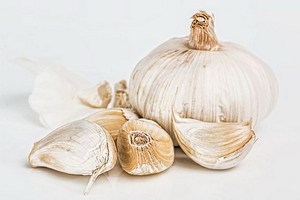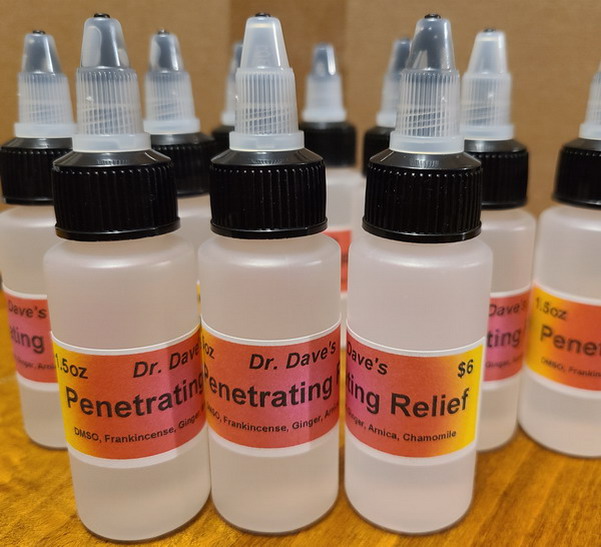 Way back when I was in college in the early 70s, I remember hearing about students using horse liniment made from DMSO on their sports injuries and getting great results. I re-encountered DMSO while in Chiropractic school as a tool for getting medications into the body without having to use a needle. This was important to Chiropractors as we are not allowed to inject folks with anything. DMSO is a solvent that absorbs through the skin and into cells super quickly and carries anything mixed with it into the body along with the DMSO. A few more years passed, and I had a friend who brought me some DMSO to try on myself and a few patients. Back then, DMSO was not available in a pharmaceutical grade for human use, so we had to use either veterinary grade or just commercial solvent grade. I was trying the horse liniment I had heard about in college. It did a nice job on inflamed joints, but it had a terrible side effect. Within a couple of minutes of using the DMSO, you would get a taste similar to rotten garlic in your mouth, and shortly thereafter your whole body would smell of rotten garlic. We stopped using it.
Way back when I was in college in the early 70s, I remember hearing about students using horse liniment made from DMSO on their sports injuries and getting great results. I re-encountered DMSO while in Chiropractic school as a tool for getting medications into the body without having to use a needle. This was important to Chiropractors as we are not allowed to inject folks with anything. DMSO is a solvent that absorbs through the skin and into cells super quickly and carries anything mixed with it into the body along with the DMSO. A few more years passed, and I had a friend who brought me some DMSO to try on myself and a few patients. Back then, DMSO was not available in a pharmaceutical grade for human use, so we had to use either veterinary grade or just commercial solvent grade. I was trying the horse liniment I had heard about in college. It did a nice job on inflamed joints, but it had a terrible side effect. Within a couple of minutes of using the DMSO, you would get a taste similar to rotten garlic in your mouth, and shortly thereafter your whole body would smell of rotten garlic. We stopped using it.
 About a year ago, I found a source of pharmaceutical-grade 99.99% DMSO, so I thought I would give it another try. I never knew if the rotten garlic reaction was from the DMSO itself or something mixed in with the DMSO. Much to my delight, when I tried it this time, I got no garlic reaction at all. Perhaps if I used more than a couple of drops at a time, I might, but so far nothing. My primary purpose for getting the DMSO was because of how well it can penetrate the skin and carry other medications along with it. I used it to create my anti-fungal treatment for toenail fungus, which has worked quite well for many folks who have used it. Now I am looking at what else I can use DMSO on.
About a year ago, I found a source of pharmaceutical-grade 99.99% DMSO, so I thought I would give it another try. I never knew if the rotten garlic reaction was from the DMSO itself or something mixed in with the DMSO. Much to my delight, when I tried it this time, I got no garlic reaction at all. Perhaps if I used more than a couple of drops at a time, I might, but so far nothing. My primary purpose for getting the DMSO was because of how well it can penetrate the skin and carry other medications along with it. I used it to create my anti-fungal treatment for toenail fungus, which has worked quite well for many folks who have used it. Now I am looking at what else I can use DMSO on.
 About a month ago, I noticed a persistent pain in my left hip that worsened after I had to work under my kitchen sink to repair a leak. Sitting cross-legged was uncomfortable as my left knee would not rest on the floor without a sharp pain in my hip. This surprised me as I do twenty squats every morning to limber up my hips in my morning stretching routine. To be clear, I am still uncertain whether it is my hip joint complaining or the bursa over the hip joint causing the pain. After a couple of weeks of discomfort, I decided to give some straight DMSO a try. I rubbed it over the affected area before going to bed, and by morning, more than half of the pain was gone. The next day, I tried it again and added in treatment with my Russian electric stim device (the DENAS) which eliminated about 80% of the pain. Today, I can still feel some pain in the area, but now my knees are also bothering me. Could this be the joy of turning 70?
About a month ago, I noticed a persistent pain in my left hip that worsened after I had to work under my kitchen sink to repair a leak. Sitting cross-legged was uncomfortable as my left knee would not rest on the floor without a sharp pain in my hip. This surprised me as I do twenty squats every morning to limber up my hips in my morning stretching routine. To be clear, I am still uncertain whether it is my hip joint complaining or the bursa over the hip joint causing the pain. After a couple of weeks of discomfort, I decided to give some straight DMSO a try. I rubbed it over the affected area before going to bed, and by morning, more than half of the pain was gone. The next day, I tried it again and added in treatment with my Russian electric stim device (the DENAS) which eliminated about 80% of the pain. Today, I can still feel some pain in the area, but now my knees are also bothering me. Could this be the joy of turning 70?
 I started thinking about how well DMSO carries other medications into the body and theorized that it should do the same thing for anti-inflammatory essential oils. Yes, DMSO is an anti-inflammatory all on its own, but inflammation comes in many flavors, and many different pathways are involved. Compounds in essential oils tackle many different pathways, so I figured that a multi-pronged approach is better than just a single shot in the dark. This morning, I compounded my first trial blend using DMSO, frankincense, Arnica, ginger oil, and chamomile. Each of these elements works to relieve pain differently. I specifically avoided the oils that work by stimulating the nerve endings in the skin to create counter-irritation, such as camphor, peppermint, or menthol. Those don’t reduce inflammation, only mask it. I wanted stuff that would make things better if it could get down to the inflamed area. The DMSO should work to carry them down to where they will be of benefit. If this idea works out well for me, then you can expect to see it on my shelves as a new product.
I started thinking about how well DMSO carries other medications into the body and theorized that it should do the same thing for anti-inflammatory essential oils. Yes, DMSO is an anti-inflammatory all on its own, but inflammation comes in many flavors, and many different pathways are involved. Compounds in essential oils tackle many different pathways, so I figured that a multi-pronged approach is better than just a single shot in the dark. This morning, I compounded my first trial blend using DMSO, frankincense, Arnica, ginger oil, and chamomile. Each of these elements works to relieve pain differently. I specifically avoided the oils that work by stimulating the nerve endings in the skin to create counter-irritation, such as camphor, peppermint, or menthol. Those don’t reduce inflammation, only mask it. I wanted stuff that would make things better if it could get down to the inflamed area. The DMSO should work to carry them down to where they will be of benefit. If this idea works out well for me, then you can expect to see it on my shelves as a new product.
 At the same time as I was formulating this new potential product, I thought this subject would be good for a newsletter article. I have been spending this morning researching DMSO. It is amazing how little information there is out there on something that has so many benefits yet is simple and cheap. I did find a 60 Minutes exposé on DMSO that aired many years ago that you can check out here: DMSO – Dr Jacob on 60 Minutes
At the same time as I was formulating this new potential product, I thought this subject would be good for a newsletter article. I have been spending this morning researching DMSO. It is amazing how little information there is out there on something that has so many benefits yet is simple and cheap. I did find a 60 Minutes exposé on DMSO that aired many years ago that you can check out here: DMSO – Dr Jacob on 60 Minutes
 The real issue with DMSO is pointed out in this exposé. The problem is that DMSO is a simple organic solvent discovered almost 150 years ago, and no one has a patent on it. As such, no drug company can turn it into a remedy and make a profit from it. Yet, only drug companies can afford to do the kind of studies necessary to get DMSO approved by the FDA for the treatment of any condition. DMSO is approved for one bladder condition, and that is it. They admit that DMSO is safe and non-toxic. At worst, it may cause some redness or itching, and a few people have reported nausea or a headache when taking it orally. But no one is interested in doing the large double-blind studies necessary to get it approved as proven useful for any condition. (If you read between the lines a bit, this says that the FDA only approves drug companies for patent medicines.)
The real issue with DMSO is pointed out in this exposé. The problem is that DMSO is a simple organic solvent discovered almost 150 years ago, and no one has a patent on it. As such, no drug company can turn it into a remedy and make a profit from it. Yet, only drug companies can afford to do the kind of studies necessary to get DMSO approved by the FDA for the treatment of any condition. DMSO is approved for one bladder condition, and that is it. They admit that DMSO is safe and non-toxic. At worst, it may cause some redness or itching, and a few people have reported nausea or a headache when taking it orally. But no one is interested in doing the large double-blind studies necessary to get it approved as proven useful for any condition. (If you read between the lines a bit, this says that the FDA only approves drug companies for patent medicines.)
 So what we are left with is anecdotal evidence – people’s testimonials about how good this stuff is and how well it works for all kinds of things. DMSO is a natural substance that is produced as a byproduct of the paper-making industry. It is found in pine trees and is extracted from wood pulp. It is also found in garlic and onions, hence the garlic taste associated with it. It is a source of sulfur for the body, which is used in every cell in the body. DMSO stands for Dimethyl sulfoxide, which means two methyl groups (CH3) combined into a sulfur-oxygen (SO) molecule. It is about one-quarter the size of a table sugar molecule, so it is very tiny – much smaller than amino acids or fats. It is also bipolar, so it likes both water and fat, which is why it moves so easily into the cells of our body. One of the tissues in our body that uses a lot of sulfur is the cartilage in our joints, which may be part of why it seems to help so much with arthritis.
So what we are left with is anecdotal evidence – people’s testimonials about how good this stuff is and how well it works for all kinds of things. DMSO is a natural substance that is produced as a byproduct of the paper-making industry. It is found in pine trees and is extracted from wood pulp. It is also found in garlic and onions, hence the garlic taste associated with it. It is a source of sulfur for the body, which is used in every cell in the body. DMSO stands for Dimethyl sulfoxide, which means two methyl groups (CH3) combined into a sulfur-oxygen (SO) molecule. It is about one-quarter the size of a table sugar molecule, so it is very tiny – much smaller than amino acids or fats. It is also bipolar, so it likes both water and fat, which is why it moves so easily into the cells of our body. One of the tissues in our body that uses a lot of sulfur is the cartilage in our joints, which may be part of why it seems to help so much with arthritis.
 DMSO is a universal solvent that can dissolve most things, except glass or polyethylene containers. Therefore, it should not come in contact with your clothes, as it can melt your rubber gloves. While its ability to carry other chemicals into the body is useful, it can also be dangerous. Before applying DMSO, ensure your skin is thoroughly cleaned, as anything on your skin may be transported deep into the body where you may not want it. Remove any makeup or other skin lotions before using DMSO. If you have nail polish on, exercise caution to prevent dissolving and pushing it into your body.
DMSO is a universal solvent that can dissolve most things, except glass or polyethylene containers. Therefore, it should not come in contact with your clothes, as it can melt your rubber gloves. While its ability to carry other chemicals into the body is useful, it can also be dangerous. Before applying DMSO, ensure your skin is thoroughly cleaned, as anything on your skin may be transported deep into the body where you may not want it. Remove any makeup or other skin lotions before using DMSO. If you have nail polish on, exercise caution to prevent dissolving and pushing it into your body.
 Using DMSO on your body can be applied at full strength on areas of skin that get tanned. Tender skin areas prefer diluted DMSO. Just add equal portions of DMSO to distilled water and wait 15 minutes before applying. The wait is necessary because when you add water, the solution will get hot and need to cool down before you use it. I experienced that this morning and was surprised by the amount of heat it generated. Even though some doctors have used diluted DMSO as an IV treatment, and some people even drink it, I would not suggest that, as I do not have enough evidence about what it will do at that dose level. If you get the garlic breath response, it just means that your body is breaking down the DMSO into dimethyl sulfone, a gas that smells of sulfur and is expelled through the lungs. From what I have read, this is more likely if you are using a lot of it over a large area or are applying it frequently.
Using DMSO on your body can be applied at full strength on areas of skin that get tanned. Tender skin areas prefer diluted DMSO. Just add equal portions of DMSO to distilled water and wait 15 minutes before applying. The wait is necessary because when you add water, the solution will get hot and need to cool down before you use it. I experienced that this morning and was surprised by the amount of heat it generated. Even though some doctors have used diluted DMSO as an IV treatment, and some people even drink it, I would not suggest that, as I do not have enough evidence about what it will do at that dose level. If you get the garlic breath response, it just means that your body is breaking down the DMSO into dimethyl sulfone, a gas that smells of sulfur and is expelled through the lungs. From what I have read, this is more likely if you are using a lot of it over a large area or are applying it frequently.
 I am thinking that DMSO might be a holiday season gift for many of you who have been plagued with the ever-giving gift of arthritis. If that is what my hip and now knees are talking about, then I know I don’t like it. I want it gone! I’ve got another eight years of standing on my feet working to reach my goal of 50 years of being a chiropractor. I would like that to be comfortable. I imagine most of you would like to be comfortable as well.
I am thinking that DMSO might be a holiday season gift for many of you who have been plagued with the ever-giving gift of arthritis. If that is what my hip and now knees are talking about, then I know I don’t like it. I want it gone! I’ve got another eight years of standing on my feet working to reach my goal of 50 years of being a chiropractor. I would like that to be comfortable. I imagine most of you would like to be comfortable as well.
Take care,
David
Ellen 
Ellen, Amber, and I went to the Imaginarium Friday. It was a playful experience. The average age of the attendees appeared to be around 4 or 5, but we loved all the light sculptures. We even got to indulge in a bit of Fair
 Grounds junk food. Ellen had a corn dog while I had some cotton candy. Ellen loved being able to try on a pair of light wings as the picture shows here.
Grounds junk food. Ellen had a corn dog while I had some cotton candy. Ellen loved being able to try on a pair of light wings as the picture shows here.
 Never too late to diet
Never too late to diet
 Don’t eat fatty foods when stressed
Don’t eat fatty foods when stressed
 Personality affects dementia
Personality affects dementia

 Way back when I was in college in the early 70s, I remember hearing about students using horse liniment made from DMSO on their sports injuries and getting great results. I re-encountered DMSO while in Chiropractic school as a tool for getting medications into the body without having to use a needle. This was important to Chiropractors as we are not allowed to inject folks with anything. DMSO is a solvent that absorbs through the skin and into cells super quickly and carries anything mixed with it into the body along with the DMSO. A few more years passed, and I had a friend who brought me some DMSO to try on myself and a few patients. Back then, DMSO was not available in a pharmaceutical grade for human use, so we had to use either veterinary grade or just commercial solvent grade. I was trying the horse liniment I had heard about in college. It did a nice job on inflamed joints, but it had a terrible side effect. Within a couple of minutes of using the DMSO, you would get a taste similar to rotten garlic in your mouth, and shortly thereafter your whole body would smell of rotten garlic. We stopped using it.
Way back when I was in college in the early 70s, I remember hearing about students using horse liniment made from DMSO on their sports injuries and getting great results. I re-encountered DMSO while in Chiropractic school as a tool for getting medications into the body without having to use a needle. This was important to Chiropractors as we are not allowed to inject folks with anything. DMSO is a solvent that absorbs through the skin and into cells super quickly and carries anything mixed with it into the body along with the DMSO. A few more years passed, and I had a friend who brought me some DMSO to try on myself and a few patients. Back then, DMSO was not available in a pharmaceutical grade for human use, so we had to use either veterinary grade or just commercial solvent grade. I was trying the horse liniment I had heard about in college. It did a nice job on inflamed joints, but it had a terrible side effect. Within a couple of minutes of using the DMSO, you would get a taste similar to rotten garlic in your mouth, and shortly thereafter your whole body would smell of rotten garlic. We stopped using it. About a year ago, I found a source of pharmaceutical-grade 99.99% DMSO, so I thought I would give it another try. I never knew if the rotten garlic reaction was from the DMSO itself or something mixed in with the DMSO. Much to my delight, when I tried it this time, I got no garlic reaction at all. Perhaps if I used more than a couple of drops at a time, I might, but so far nothing. My primary purpose for getting the DMSO was because of how well it can penetrate the skin and carry other medications along with it. I used it to create my anti-fungal treatment for toenail fungus, which has worked quite well for many folks who have used it. Now I am looking at what else I can use DMSO on.
About a year ago, I found a source of pharmaceutical-grade 99.99% DMSO, so I thought I would give it another try. I never knew if the rotten garlic reaction was from the DMSO itself or something mixed in with the DMSO. Much to my delight, when I tried it this time, I got no garlic reaction at all. Perhaps if I used more than a couple of drops at a time, I might, but so far nothing. My primary purpose for getting the DMSO was because of how well it can penetrate the skin and carry other medications along with it. I used it to create my anti-fungal treatment for toenail fungus, which has worked quite well for many folks who have used it. Now I am looking at what else I can use DMSO on. About a month ago, I noticed a persistent pain in my left hip that worsened after I had to work under my kitchen sink to repair a leak. Sitting cross-legged was uncomfortable as my left knee would not rest on the floor without a sharp pain in my hip. This surprised me as I do twenty squats every morning to limber up my hips in my morning stretching routine. To be clear, I am still uncertain whether it is my hip joint complaining or the bursa over the hip joint causing the pain. After a couple of weeks of discomfort, I decided to give some straight DMSO a try. I rubbed it over the affected area before going to bed, and by morning, more than half of the pain was gone. The next day, I tried it again and added in treatment with my Russian electric stim device (the DENAS) which eliminated about 80% of the pain. Today, I can still feel some pain in the area, but now my knees are also bothering me. Could this be the joy of turning 70?
About a month ago, I noticed a persistent pain in my left hip that worsened after I had to work under my kitchen sink to repair a leak. Sitting cross-legged was uncomfortable as my left knee would not rest on the floor without a sharp pain in my hip. This surprised me as I do twenty squats every morning to limber up my hips in my morning stretching routine. To be clear, I am still uncertain whether it is my hip joint complaining or the bursa over the hip joint causing the pain. After a couple of weeks of discomfort, I decided to give some straight DMSO a try. I rubbed it over the affected area before going to bed, and by morning, more than half of the pain was gone. The next day, I tried it again and added in treatment with my Russian electric stim device (the DENAS) which eliminated about 80% of the pain. Today, I can still feel some pain in the area, but now my knees are also bothering me. Could this be the joy of turning 70? I started thinking about how well DMSO carries other medications into the body and theorized that it should do the same thing for anti-inflammatory essential oils. Yes, DMSO is an anti-inflammatory all on its own, but inflammation comes in many flavors, and many different pathways are involved. Compounds in essential oils tackle many different pathways, so I figured that a multi-pronged approach is better than just a single shot in the dark. This morning, I compounded my first trial blend using DMSO, frankincense, Arnica, ginger oil, and chamomile. Each of these elements works to relieve pain differently. I specifically avoided the oils that work by stimulating the nerve endings in the skin to create counter-irritation, such as camphor, peppermint, or menthol. Those don’t reduce inflammation, only mask it. I wanted stuff that would make things better if it could get down to the inflamed area. The DMSO should work to carry them down to where they will be of benefit. If this idea works out well for me, then you can expect to see it on my shelves as a new product.
I started thinking about how well DMSO carries other medications into the body and theorized that it should do the same thing for anti-inflammatory essential oils. Yes, DMSO is an anti-inflammatory all on its own, but inflammation comes in many flavors, and many different pathways are involved. Compounds in essential oils tackle many different pathways, so I figured that a multi-pronged approach is better than just a single shot in the dark. This morning, I compounded my first trial blend using DMSO, frankincense, Arnica, ginger oil, and chamomile. Each of these elements works to relieve pain differently. I specifically avoided the oils that work by stimulating the nerve endings in the skin to create counter-irritation, such as camphor, peppermint, or menthol. Those don’t reduce inflammation, only mask it. I wanted stuff that would make things better if it could get down to the inflamed area. The DMSO should work to carry them down to where they will be of benefit. If this idea works out well for me, then you can expect to see it on my shelves as a new product. At the same time as I was formulating this new potential product, I thought this subject would be good for a newsletter article. I have been spending this morning researching DMSO. It is amazing how little information there is out there on something that has so many benefits yet is simple and cheap. I did find a 60 Minutes exposé on DMSO that aired many years ago that you can check out here: DMSO –
At the same time as I was formulating this new potential product, I thought this subject would be good for a newsletter article. I have been spending this morning researching DMSO. It is amazing how little information there is out there on something that has so many benefits yet is simple and cheap. I did find a 60 Minutes exposé on DMSO that aired many years ago that you can check out here: DMSO –  The real issue with DMSO is pointed out in this exposé. The problem is that DMSO is a simple organic solvent discovered almost 150 years ago, and no one has a patent on it. As such, no drug company can turn it into a remedy and make a profit from it. Yet, only drug companies can afford to do the kind of studies necessary to get DMSO approved by the FDA for the treatment of any condition. DMSO is approved for one bladder condition, and that is it. They admit that DMSO is safe and non-toxic. At worst, it may cause some redness or itching, and a few people have reported nausea or a headache when taking it orally. But no one is interested in doing the large double-blind studies necessary to get it approved as proven useful for any condition. (If you read between the lines a bit, this says that the FDA only approves drug companies for patent medicines.)
The real issue with DMSO is pointed out in this exposé. The problem is that DMSO is a simple organic solvent discovered almost 150 years ago, and no one has a patent on it. As such, no drug company can turn it into a remedy and make a profit from it. Yet, only drug companies can afford to do the kind of studies necessary to get DMSO approved by the FDA for the treatment of any condition. DMSO is approved for one bladder condition, and that is it. They admit that DMSO is safe and non-toxic. At worst, it may cause some redness or itching, and a few people have reported nausea or a headache when taking it orally. But no one is interested in doing the large double-blind studies necessary to get it approved as proven useful for any condition. (If you read between the lines a bit, this says that the FDA only approves drug companies for patent medicines.) So what we are left with is anecdotal evidence – people’s testimonials about how good this stuff is and how well it works for all kinds of things. DMSO is a natural substance that is produced as a byproduct of the paper-making industry. It is found in pine trees and is extracted from wood pulp. It is also found in garlic and onions, hence the garlic taste associated with it. It is a source of sulfur for the body, which is used in every cell in the body. DMSO stands for Dimethyl sulfoxide, which means two methyl groups (CH3) combined into a sulfur-oxygen (SO) molecule. It is about one-quarter the size of a table sugar molecule, so it is very tiny – much smaller than amino acids or fats. It is also bipolar, so it likes both water and fat, which is why it moves so easily into the cells of our body. One of the tissues in our body that uses a lot of sulfur is the cartilage in our joints, which may be part of why it seems to help so much with arthritis.
So what we are left with is anecdotal evidence – people’s testimonials about how good this stuff is and how well it works for all kinds of things. DMSO is a natural substance that is produced as a byproduct of the paper-making industry. It is found in pine trees and is extracted from wood pulp. It is also found in garlic and onions, hence the garlic taste associated with it. It is a source of sulfur for the body, which is used in every cell in the body. DMSO stands for Dimethyl sulfoxide, which means two methyl groups (CH3) combined into a sulfur-oxygen (SO) molecule. It is about one-quarter the size of a table sugar molecule, so it is very tiny – much smaller than amino acids or fats. It is also bipolar, so it likes both water and fat, which is why it moves so easily into the cells of our body. One of the tissues in our body that uses a lot of sulfur is the cartilage in our joints, which may be part of why it seems to help so much with arthritis. DMSO is a universal solvent that can dissolve most things, except glass or polyethylene containers. Therefore, it should not come in contact with your clothes, as it can melt your rubber gloves. While its ability to carry other chemicals into the body is useful, it can also be dangerous. Before applying DMSO, ensure your skin is thoroughly cleaned, as anything on your skin may be transported deep into the body where you may not want it. Remove any makeup or other skin lotions before using DMSO. If you have nail polish on, exercise caution to prevent dissolving and pushing it into your body.
DMSO is a universal solvent that can dissolve most things, except glass or polyethylene containers. Therefore, it should not come in contact with your clothes, as it can melt your rubber gloves. While its ability to carry other chemicals into the body is useful, it can also be dangerous. Before applying DMSO, ensure your skin is thoroughly cleaned, as anything on your skin may be transported deep into the body where you may not want it. Remove any makeup or other skin lotions before using DMSO. If you have nail polish on, exercise caution to prevent dissolving and pushing it into your body. Using DMSO on your body can be applied at full strength on areas of skin that get tanned. Tender skin areas prefer diluted DMSO. Just add equal portions of DMSO to distilled water and wait 15 minutes before applying. The wait is necessary because when you add water, the solution will get hot and need to cool down before you use it. I experienced that this morning and was surprised by the amount of heat it generated. Even though some doctors have used diluted DMSO as an IV treatment, and some people even drink it, I would not suggest that, as I do not have enough evidence about what it will do at that dose level. If you get the garlic breath response, it just means that your body is breaking down the DMSO into dimethyl sulfone, a gas that smells of sulfur and is expelled through the lungs. From what I have read, this is more likely if you are using a lot of it over a large area or are applying it frequently.
Using DMSO on your body can be applied at full strength on areas of skin that get tanned. Tender skin areas prefer diluted DMSO. Just add equal portions of DMSO to distilled water and wait 15 minutes before applying. The wait is necessary because when you add water, the solution will get hot and need to cool down before you use it. I experienced that this morning and was surprised by the amount of heat it generated. Even though some doctors have used diluted DMSO as an IV treatment, and some people even drink it, I would not suggest that, as I do not have enough evidence about what it will do at that dose level. If you get the garlic breath response, it just means that your body is breaking down the DMSO into dimethyl sulfone, a gas that smells of sulfur and is expelled through the lungs. From what I have read, this is more likely if you are using a lot of it over a large area or are applying it frequently. I am thinking that DMSO might be a holiday season gift for many of you who have been plagued with the ever-giving gift of arthritis. If that is what my hip and now knees are talking about, then I know I don’t like it. I want it gone! I’ve got another eight years of standing on my feet working to reach my goal of 50 years of being a chiropractor. I would like that to be comfortable. I imagine most of you would like to be comfortable as well.
I am thinking that DMSO might be a holiday season gift for many of you who have been plagued with the ever-giving gift of arthritis. If that is what my hip and now knees are talking about, then I know I don’t like it. I want it gone! I’ve got another eight years of standing on my feet working to reach my goal of 50 years of being a chiropractor. I would like that to be comfortable. I imagine most of you would like to be comfortable as well.
 Grounds junk food. Ellen had a corn dog while I had some cotton candy. Ellen loved being able to try on a pair of light wings as the picture shows here.
Grounds junk food. Ellen had a corn dog while I had some cotton candy. Ellen loved being able to try on a pair of light wings as the picture shows here.